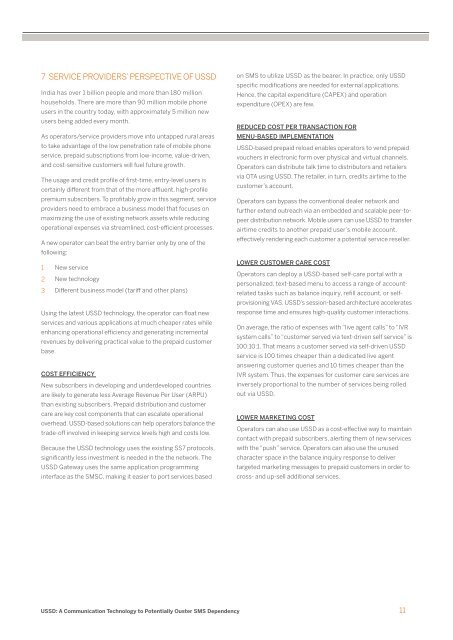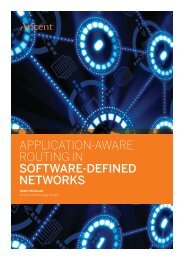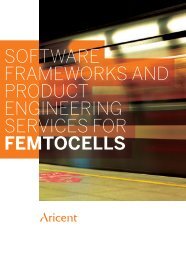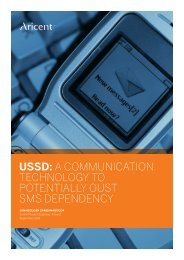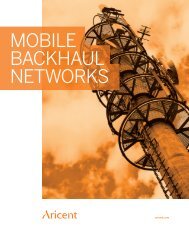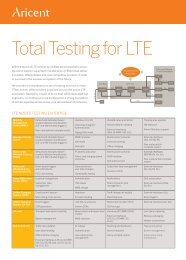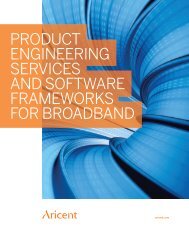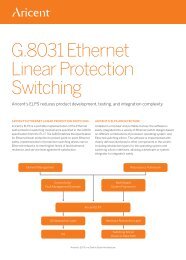ussd: a communication technology to potentially oust sms ... - Aricent
ussd: a communication technology to potentially oust sms ... - Aricent
ussd: a communication technology to potentially oust sms ... - Aricent
- No tags were found...
You also want an ePaper? Increase the reach of your titles
YUMPU automatically turns print PDFs into web optimized ePapers that Google loves.
7 SERVICE PROVIDERS’ PERSPECTIVE OF USSDIndia has over 1 billion people and more than 180 millionhouseholds. There are more than 90 million mobile phoneusers in the country <strong>to</strong>day, with approximately 5 million newusers being added every month.As opera<strong>to</strong>rs/service providers move in<strong>to</strong> untapped rural areas<strong>to</strong> take advantage of the low penetration rate of mobile phoneservice, prepaid subscriptions from low-income, value-driven,and cost-sensitive cus<strong>to</strong>mers will fuel future growth.The usage and credit profile of first-time, entry-level users iscertainly different from that of the more affluent, high-profilepremium subscribers. To profitably grow in this segment, serviceproviders need <strong>to</strong> embrace a business model that focuses onmaximizing the use of existing network assets while reducingoperational expenses via streamlined, cost-efficient processes.A new opera<strong>to</strong>r can beat the entry barrier only by one of thefollowing:1 New service2 New <strong>technology</strong>3 Different business model (tariff and other plans)Using the latest USSD <strong>technology</strong>, the opera<strong>to</strong>r can float newservices and various applications at much cheaper rates whileenhancing operational efficiency and generating incrementalrevenues by delivering practical value <strong>to</strong> the prepaid cus<strong>to</strong>merbase.COST EFFICIENCYNew subscribers in developing and underdeveloped countriesare likely <strong>to</strong> generate less Average Revenue Per User (ARPU)than existing subscribers. Prepaid distribution and cus<strong>to</strong>mercare are key cost components that can escalate operationaloverhead. USSD-based solutions can help opera<strong>to</strong>rs balance thetrade-off involved in keeping service levels high and costs low.Because the USSD <strong>technology</strong> uses the existing SS7 pro<strong>to</strong>cols,significantly less investment is needed in the the network. TheUSSD Gateway uses the same application programminginterface as the SMSC, making it easier <strong>to</strong> port services basedon SMS <strong>to</strong> utilize USSD as the bearer. In practice, only USSDspecific modifications are needed for external applications.Hence, the capital expenditure (CAPEX) and operationexpenditure (OPEX) are few.REDUCED COST PER TRANSACTION FORMENU-BASED IMPLEMENTATIONUSSD-based prepaid reload enables opera<strong>to</strong>rs <strong>to</strong> vend prepaidvouchers in electronic form over physical and virtual channels.Opera<strong>to</strong>rs can distribute talk time <strong>to</strong> distribu<strong>to</strong>rs and retailersvia OTA using USSD. The retailer, in turn, credits airtime <strong>to</strong> thecus<strong>to</strong>mer’s account.Opera<strong>to</strong>rs can bypass the conventional dealer network andfurther extend outreach via an embedded and scalable peer-<strong>to</strong>peerdistribution network. Mobile users can use USSD <strong>to</strong> transferairtime credits <strong>to</strong> another prepaid user’s mobile account,effectively rendering each cus<strong>to</strong>mer a potential service reseller.LOWER CUSTOMER CARE COSTOpera<strong>to</strong>rs can deploy a USSD-based self-care portal with apersonalized, text-based menu <strong>to</strong> access a range of accountrelatedtasks such as balance inquiry, refill account, or selfprovisioningVAS. USSD’s session-based architecture acceleratesresponse time and ensures high-quality cus<strong>to</strong>mer interactions.On average, the ratio of expenses with “live agent calls” <strong>to</strong> “IVRsystem calls” <strong>to</strong> “cus<strong>to</strong>mer served via text-driven self service” is100:10:1. That means a cus<strong>to</strong>mer served via self-driven USSDservice is 100 times cheaper than a dedicated live agentanswering cus<strong>to</strong>mer queries and 10 times cheaper than theIVR system. Thus, the expenses for cus<strong>to</strong>mer care services areinversely proportional <strong>to</strong> the number of services being rolledout via USSD.LOWER MARKETING COSTOpera<strong>to</strong>rs can also use USSD as a cost-effective way <strong>to</strong> maintaincontact with prepaid subscribers, alerting them of new serviceswith the “push” service. Opera<strong>to</strong>rs can also use the unusedcharacter space in the balance inquiry response <strong>to</strong> delivertargeted marketing messages <strong>to</strong> prepaid cus<strong>to</strong>mers in order <strong>to</strong>cross- and up-sell additional services.USSD: A Communication Technology <strong>to</strong> Potentially Ouster SMS Dependency11


